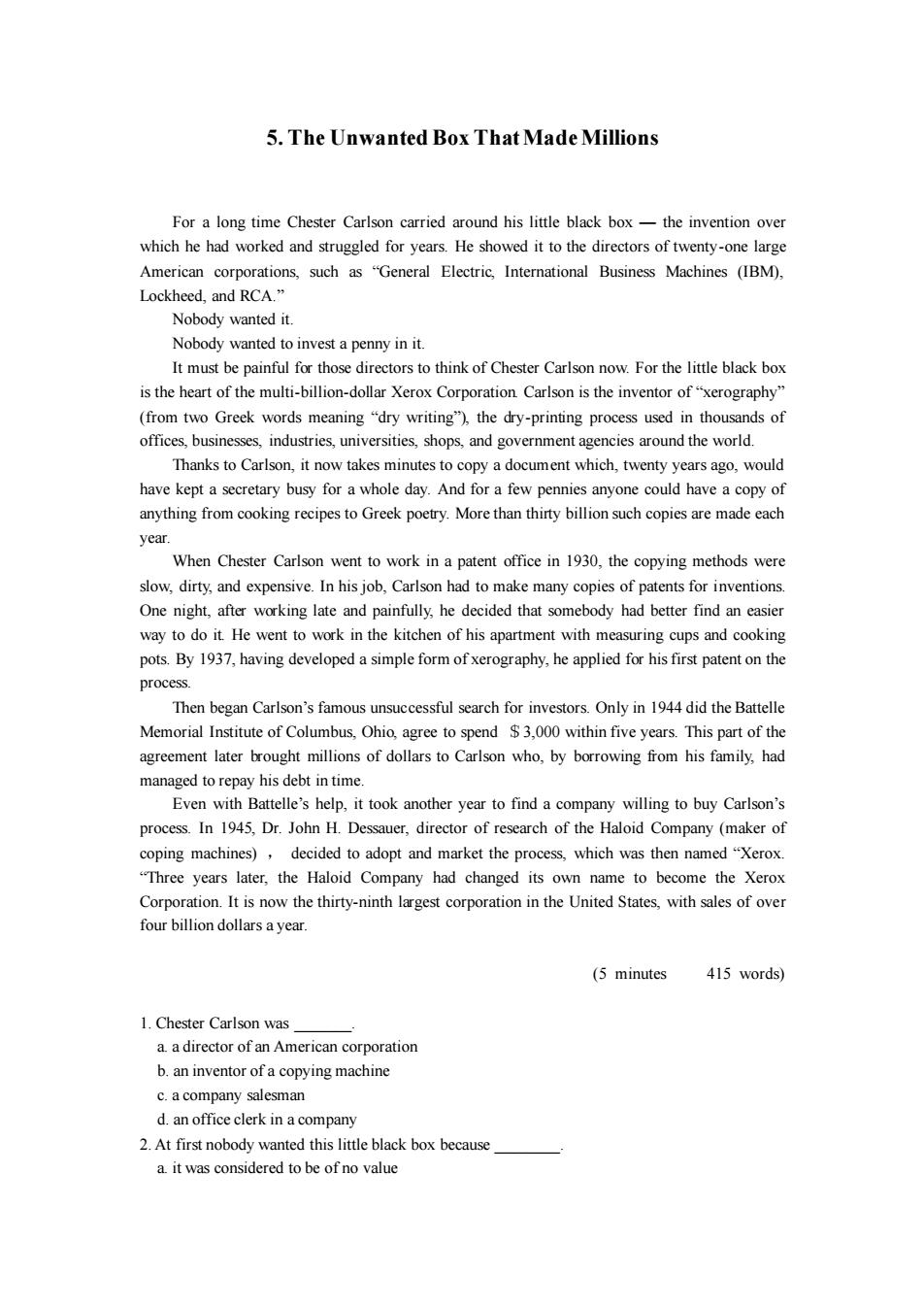正在加载图片...

5.The Unwanted Box That Made Millions For a long time Chester Carlson carried around his little black box-the invention over which he had worked and struggled for years.He showed it to the directors of twenty-one large American corporations,such as "General Electric.International Business Machines (IBM). Lockheed,and RCA body wanted it. Nobody wanted to invest a penny in it. It must be painful for those directors to think of Chester Carlson now.For the little black box is the heart of the multi-billion-dollar Xerox Corporation Carlson is the inventor ofxerography" (from two Greck words meaning"dry writing").the ry-printing proces used in thou offices,business industries,universities shops and around the orld Thanks to Carlson.it now takes minutes to copy a document which,twenty years ago,would have kept a secretary busy for a whole day.And for a few pennies anyone could have a copy of anything from cooking recipes to Greek poetry.More than thirty billion such copies are made each When Chester Carlson went to ork in a patent office in 1930,the copying methods were slow,dirty,and expensive.In his job,Carlson had to make many copies of patents for inventions One night,after working late and painfully,he decided that somebody had better find an easier way to do it.He went to work in the kitchen of his apartment with measuring cups and cooking Then began Carlson's famous unsuccessful search for investors.Only in 1944did the Battelle Memorial Institute of Columbus,Ohio agree to spend $3,000 within five years.This part of the agreement later brought millions of dollars to Carlson who.by borrowing from his family.had managed to repay his debt in time. Even with Battelle's help,it took another year to find a co willing to buy Carlson's proces.In 1945.Dr.John H.Dessauer.director of research of the Haloid Company (makerof coping machines),decided to adopt and market the process,which was then named "Xerox "Three years later,the Haloid Company had changed its own name to become the Xerox Corporation.It is now the thirty-ninth largest corporation in the United States.with sales of over four billion dollars a vear (5minutes 415 words) 1 Chester Carlson was a.a director of an american corporation b.an inventor of a copying machin c.a company sale sman d.an office clerk in a company 2.At first nobody wanted this little black box because a.it was considered to be of no value 5. The Unwanted Box That Made Millions For a long time Chester Carlson carried around his little black box — the invention over which he had worked and struggled for years. He showed it to the directors of twenty-one large American corporations, such as “General Electric, International Business Machines (IBM), Lockheed, and RCA.” Nobody wanted it. Nobody wanted to invest a penny in it. It must be painful for those directors to think of Chester Carlson now. For the little black box is the heart of the multi-billion-dollar Xerox Corporation. Carlson is the inventor of “xerography” (from two Greek words meaning “dry writing”), the dry-printing process used in thousands of offices, businesses, industries, universities, shops, and government agencies around the world. Thanks to Carlson, it now takes minutes to copy a document which, twenty years ago, would have kept a secretary busy for a whole day. And for a few pennies anyone could have a copy of anything from cooking recipes to Greek poetry. More than thirty billion such copies are made each year. When Chester Carlson went to work in a patent office in 1930, the copying methods were slow, dirty, and expensive. In his job, Carlson had to make many copies of patents for inventions. One night, after working late and painfully, he decided that somebody had better find an easier way to do it. He went to work in the kitchen of his apartment with measuring cups and cooking pots. By 1937, having developed a simple form of xerography, he applied for his first patent on the process. Then began Carlson’s famous unsuccessful search for investors. Only in 1944 did the Battelle Memorial Institute of Columbus, Ohio, agree to spend $3,000 within five years. This part of the agreement later brought millions of dollars to Carlson who, by borrowing from his family, had managed to repay his debt in time. Even with Battelle’s help, it took another year to find a company willing to buy Carlson’s process. In 1945, Dr. John H. Dessauer, director of research of the Haloid Company (maker of coping machines) , decided to adopt and market the process, which was then named “Xerox. “Three years later, the Haloid Company had changed its own name to become the Xerox Corporation. It is now the thirty-ninth largest corporation in the United States, with sales of over four billion dollars a year. (5 minutes 415 words) 1. Chester Carlson was _______. a. a director of an American corporation b. an inventor of a copying machine c. a company salesman d. an office clerk in a company 2. At first nobody wanted this little black box because ________. a. it was considered to be of no value